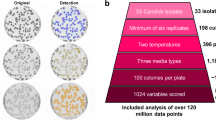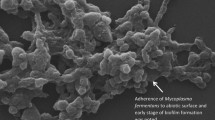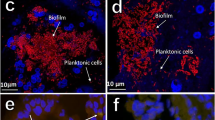Abstract
The extracellular matrix of biofilm is unique to the biofilm lifestyle, and it has key roles in community survival. A complete understanding of the biochemical nature of the matrix is integral to the understanding of the roles of matrix components. This knowledge is a first step toward the development of novel therapeutics and diagnostics to address persistent biofilm infections. Many of the assay methods needed for refined matrix composition analysis require milligram amounts of material that is separated from the cellular components of these complex communities. The protocol described here explains the large-scale production and isolation of the Candida biofilm extracellular matrix. To our knowledge, the proposed procedure is the only currently available approach in the field that yields milligram amounts of biofilm matrix. This procedure first requires biofilms to be seeded in large-surface-area roller bottles, followed by cell adhesion and biofilm maturation during continuous movement of the medium across the surface of the rotating bottle. The formed matrix is then separated from the entire biomass using sonication, which efficiently removes the matrix without perturbing the fungal cell wall. Subsequent filtration, dialysis and lyophilization steps result in a purified matrix product sufficient for biochemical, structural and functional assays. The overall protocol takes ∼11 d to complete. This protocol has been used for Candida species, but, using the troubleshooting guide provided, it could be adapted for other fungi or bacteria.
This is a preview of subscription content, access via your institution
Access options
Subscribe to this journal
Receive 12 print issues and online access
$259.00 per year
only $21.58 per issue
Buy this article
- Purchase on Springer Link
- Instant access to full article PDF
Prices may be subject to local taxes which are calculated during checkout



Similar content being viewed by others
References
Kojic, E.M. & Darouiche, R.O. Candida infections of medical devices. Clin. Microbiol. Rev. 17, 255–267 (2004).
O'Toole, G., Kaplan, H.B. & Kolter, R. Biofilm formation as microbial development. Annu. Rev. Microbiol. 54, 49–79 (2000).
Costerton, J.W., Stewart, P.S. & Greenberg, E.P. Bacterial biofilms: a common cause of persistent infections. Science 284, 1318–1322 (1999).
Fanning, S. & Mitchell, A.P. Fungal biofilms. PLoS Pathog. 8, e1002585 (2012).
Flemming, H.C. & Wingender, J. The biofilm matrix. Nat. Rev. Microbiol. 8, 623–633 (2010).
Branda, S.S., Vik, S., Friedman, L. & Kolter, R. Biofilms: the matrix revisited. Trends Microbiol. 13, 20–26 (2005).
Nett, J.E . et al. Host contributions to construction of three device-associated Candida albicans biofilms. Infect. Immun. 83, 4630–4638 (2015).
Jabra-Rizk, M.A., Falkler, W.A. & Meiller, T.F. Fungal biofilms and drug resistance. Emerg. Infect. Dis. 10, 14–19 (2004).
Vediyappan, G., Rossignol, T. & d'Enfert, C. Interaction of Candida albicans biofilms with antifungals: transcriptional response and binding of antifungals to beta-glucans. Antimicrob. Agents Chemother. 54, 2096–2111 (2010).
Baillie, G.S. & Douglas, L.J. Effect of growth rate on resistance of Candida albicans biofilms to antifungal agents. Antimicrob. Agents Chemother. 42, 1900–1905 (1998).
Baillie, G.S. & Douglas, L.J. Matrix polymers of Candida biofilms and their possible role in biofilm resistance to antifungal agents. J. Antimicrob. Chemother. 46, 397–403 (2000).
Beauvais, A . et al. An extracellular matrix glues together the aerial-grown hyphae of Aspergillus fumigatus. Cell. Microbiol. 9, 1588–1600 (2007).
Branda, S.S., Chu, F., Kearns, D.B., Losick, R. & Kolter, R. A major protein component of the Bacillus subtilis biofilm matrix. Mol. Microbiol. 59, 1229–1238 (2006).
Zarnowski, R . et al. Novel entries in a fungal biofilm matrix encyclopedia. MBio 5, e01333–01314 (2014).
O'Toole, G.A. To build a biofilm. J. Bacteriol. 185, 2687–2689 (2003).
Al-Fattani, M.A. & Douglas, L.J. Biofilm matrix of Candida albicans and Candida tropicalis: chemical composition and role in drug resistance. J. Med. Microbiol. 55, 999–1008 (2006).
Thomas, D.P., Bachmann, S.P. & Lopez-Ribot, J.L. Proteomics for the analysis of the Candida albicans biofilm lifestyle. Proteomics 6, 5795–5804 (2006).
Pierce, C.G . et al. A simple and reproducible 96-well plate-based method for the formation of fungal biofilms and its application to antifungal susceptibility testing. Nat. Protoc. 3, 1494–1500 (2008).
Lattif, A.A . et al. Proteomics and pathway mapping analyses reveal phase-dependent over-expression of proteins associated with carbohydrate metabolic pathways in Candida albicans biofilms. Open Proteom. J. 1, 5–26 (2008).
Beauvais, A., Loussert, C., Prevost, M.C., Verstrepen, K. & Latge, J.P. Characterization of a biofilm-like extracellular matrix in FLO1-expressing Saccharomyces cerevisiae cells. FEMS Yeast Res. 9, 411–419 (2009).
Loussert, C . et al. In vivo biofilm composition of Aspergillus fumigatus. Cell. Microbiol. 12, 405–410 (2010).
Gey, G.O. An improved technic for massive tissue culture. Am. J. Cancer 17, 752–756 (1933).
Dominguez, E . et al. 13th ASM Conference on Candida and Candidiasis Abstract no. 148 (American Society for Microbiology, 2016).
Nachlas, M.M., Margulies, S.I., Goldberg, J.D. & Seligman, A.M. The determination of lactic dehydrogenase with a tetrazolium salt. Anal. Biochem. 1, 317–326 (1960).
DuBois, M., Gilles, K.A., Hamilton, J.K., Rebers, P.A. & Smith, F. Colorimetric method for determination of sugars and related substances. Anal. Chem. 28, 350–356 (1956).
Smith, P.K . et al. Measurement of protein using bicinchoninic acid. Anal. Biochem. 150, 76–85 (1985).
Taff, H.T . et al. A Candida biofilm-induced pathway for matrix glucan delivery: implications for drug resistance. PLoS Pathog. 8, e1002848 (2012).
Mitchell, K.F . et al. Community participation in biofilm matrix assembly and function. Proc. Natl. Acad. Sci. USA 112, 4092–4097 (2015).
Chandra, J., Mukherjee, P.K. & Ghannoum, M.A. In vitro growth and analysis of Candida biofilms. Nat. Protoc. 3, 1909–1924 (2008).
Anonymous. A guide to freeze drying for the laboratory. An industry service publication. 1–12 (Labconco, 2010).
Acknowledgements
This work was funded by NIH R01 AI073289 (to D.R.A.). The C. albicans SN250, C. tropicalis CAY2597, C. parapsilosis CLib21, and C. glabrata ATCC2001 strains were generous gifts kindly provided by S. Noble (University of California–San Francisco), R. Bennett (Brown University), G. Butler (University College Dublin) and B. Cormack (John Hopkins University), respectively.
Author information
Authors and Affiliations
Contributions
R.Z., H.S. and D.R.A. designed the research. R.Z. and H.S. performed experiments, and validated and optimized the protocol. R.Z. and D.R.A. wrote and edited the manuscript.
Corresponding author
Ethics declarations
Competing interests
The authors declare no competing financial interests.
Rights and permissions
About this article
Cite this article
Zarnowski, R., Sanchez, H. & Andes, D. Large-scale production and isolation of Candida biofilm extracellular matrix. Nat Protoc 11, 2320–2327 (2016). https://doi.org/10.1038/nprot.2016.132
Published:
Issue Date:
DOI: https://doi.org/10.1038/nprot.2016.132
This article is cited by
-
Coordination of fungal biofilm development by extracellular vesicle cargo
Nature Communications (2021)
Comments
By submitting a comment you agree to abide by our Terms and Community Guidelines. If you find something abusive or that does not comply with our terms or guidelines please flag it as inappropriate.



